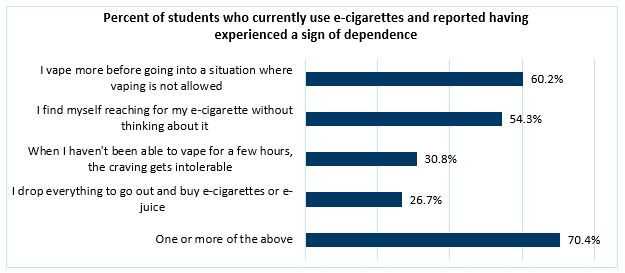News Release
February 23, 2021
New survey shows youth vaping remains a serious challenge in Minnesota
Data indicate many young people who use e-cigarettes show signs of dependence
Minnesota kids are still vaping at very high rates, with one in five high school students using e-cigarettes and 70% of high school and middle school users reporting signs of nicotine dependence, according to new data from the 2020 Minnesota Youth Tobacco Survey.
The Minnesota Youth Tobacco Survey (MYTS) has been conducted by the Minnesota Department of Health since 2000 to provide information about the commercial tobacco use of young people and to design and evaluate prevention efforts.
The survey suggests public health efforts have slowed the rapid growth of e-cigarette use seen in recent years. E-cigarette use held steady in 2020 compared to 2017. Overall tobacco use declined to 20.5% of high school and 4.1% of middle school students having used a tobacco product in the past 30 days, compared to 26.4% (high school) and 5.2% (middle school) in 2017.
The new Minnesota data also shows about four in five Minnesota students (78.4%) reported that the first tobacco product they ever tried was flavored.
“This research suggests our public health efforts are working but also that there is a need for continued work,” said Minnesota Commissioner of Health Jan Malcolm. “In particular, the data on youth vaping alarms us, as we see how this industry continues to use flavors, advertising, internet sales and other tactics to keep addicting youth to harmful nicotine.”
Youth vaping remains at epidemic levels. One recent study published in the U.S. Centers for Disease Control and Prevention’s Morbidity and Mortality Weekly Report (MMWR) showed an estimated 3.6 million youth in the United States use e-cigarettes.
The COVID-19 pandemic underscores the need to reduce commercial tobacco addiction and improve lung health. Current and former smokers are at higher risk for getting severely ill from COVID-19. E-cigarette aerosol may damage lung tissue, especially concerning during a respiratory pandemic.
Nicotine dependence results
The 2020 state survey included for the first time a four-item nicotine dependence scale for e-cigarettes. Overall, 70.4% of students who used e-cigarettes in the past 30 days reported one or more signs of dependence; these products are being used with greater intensity.

“These new data are consistent with conversations I’ve had with teens over the past three years in focus groups we conducted about youth vaping behavior and in our vaping prevention workshops,” said Elyse Levine Less, executive director at the Tobacco-Free Alliance. “Teens do not intend to get addicted to nicotine and underestimate the risk.”
Nicotine can harm the developing adolescent brain. Because the brain is still developing until about age 25, youth and young adult exposure to nicotine can lead to addiction and disrupt attention and learning. No amount of nicotine is safe for youth.

They are surprised how easy it is to lose control and become nicotine dependent, something that they never could imagine happening to them,” Less said. “I’ve heard kids say, ‘I wish I didn’t have to do this [vape]’ but can’t pinpoint when they lost their choice in the matter.”
The survey also provided insight into youth who vape marijuana. Among students who use e-cigarettes, 65.1% of high school and 71.7% of middle school students had ever vaped marijuana, a statistically significantly increase from 2017.
“The good news is that we know what it takes to make a positive change; we just need to act,” said Commissioner Malcolm. “Minnesota needs a comprehensive approach to reverse the youth tobacco epidemic.”
Minnesota’s cities and counties already have the authority to limit the sale of menthol and other flavored commercial tobacco products, which are known to appeal to youth. Some communities have already taken these steps.
These new data do offer some good news. The use of cigarettes and cigars has dropped to the lowest rates ever recorded by the survey. Just over 3% of high school students report smoking cigarettes over the last 30 days – a steep decline from 2017. Cigar use among high school students is now also just as low.
Preventing youth commercial tobacco use, including the use of e-cigarettes, requires a sustainable and comprehensive approach. Large-scale prevention efforts, such as counter-marketing to raise awareness of the dangers of these products and measures to reduce youth access to these products in their communities, have been shown to be effective.
For youth ready to break free from nicotine addiction, Minnesota has a new program to help them quit. My Life, My QuitTM, part of the state’s Quit PartnerTM family of programs, is completely free and confidential. My Life, My Quit coaches can help teens develop a quit plan, cope with stress, learn about nicotine, and get ongoing support. Teens can chat with a coach online at MyLifeMyQuit.com or text “Start” to 36072.
Learn more at Tobacco Prevention and Control.
-MDH-
Media inquiries:
Scott Smith
MDH Communications
651-503-1440
scott.smith@state.mn.us (preferred)